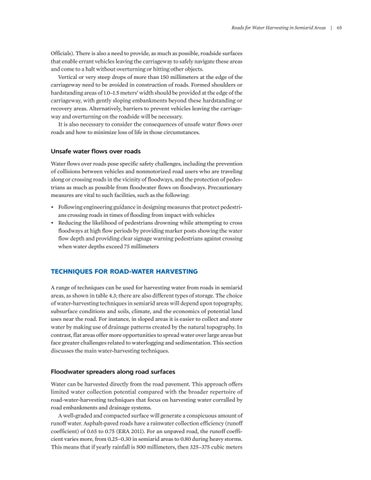Roads for Water Harvesting in Semiarid Areas | 65
Officials). There is also a need to provide, as much as possible, roadside surfaces that enable errant vehicles leaving the carriageway to safely navigate these areas and come to a halt without overturning or hitting other objects. Vertical or very steep drops of more than 150 millimeters at the edge of the carriageway need to be avoided in construction of roads. Formed shoulders or hardstanding areas of 1.0–1.5 meters’ width should be provided at the edge of the carriageway, with gently sloping embankments beyond these hardstanding or recovery areas. Alternatively, barriers to prevent vehicles leaving the carriageway and overturning on the roadside will be necessary. It is also necessary to consider the consequences of unsafe water flows over roads and how to minimize loss of life in those circumstances.
Unsafe water flows over roads Water flows over roads pose specific safety challenges, including the prevention of collisions between vehicles and nonmotorized road users who are traveling along or crossing roads in the vicinity of floodways, and the protection of pedestrians as much as possible from floodwater flows on floodways. Precautionary measures are vital to such facilities, such as the following: • Following engineering guidance in designing measures that protect pedestrians crossing roads in times of flooding from impact with vehicles • Reducing the likelihood of pedestrians drowning while attempting to cross floodways at high flow periods by providing marker posts showing the water flow depth and providing clear signage warning pedestrians against crossing when water depths exceed 75 millimeters
TECHNIQUES FOR ROAD-WATER HARVESTING A range of techniques can be used for harvesting water from roads in semiarid areas, as shown in table 4.3; there are also different types of storage. The choice of water-harvesting techniques in semiarid areas will depend upon topography, subsurface conditions and soils, climate, and the economics of potential land uses near the road. For instance, in sloped areas it is easier to collect and store water by making use of drainage patterns created by the natural topography. In contrast, flat areas offer more opportunities to spread water over large areas but face greater challenges related to waterlogging and sedimentation. This section discusses the main water-harvesting techniques.
Floodwater spreaders along road surfaces Water can be harvested directly from the road pavement. This approach offers limited water collection potential compared with the broader repertoire of road-water-harvesting techniques that focus on harvesting water corralled by road embankments and drainage systems. A well-graded and compacted surface will generate a conspicuous amount of runoff water. Asphalt-paved roads have a rainwater collection efficiency (runoff coefficient) of 0.65 to 0.75 (ERA 2011). For an unpaved road, the runoff coefficient varies more, from 0.25–0.30 in semiarid areas to 0.80 during heavy storms. This means that if yearly rainfall is 500 millimeters, then 325–375 cubic meters







































